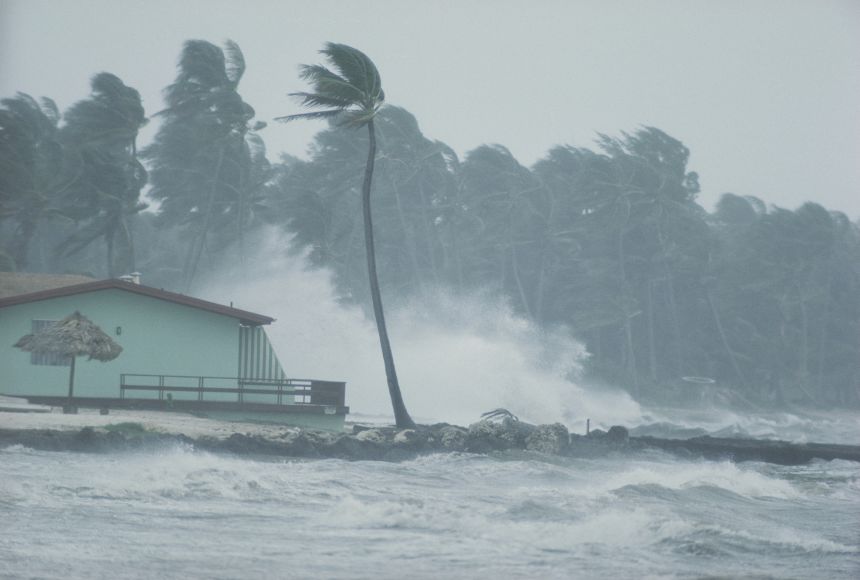The 2005 hurricane season was unlike any other hurricane season before it. There were fifteen hurricanes severe enough to be given a name — a record. Four of these hurricanes were classified as Category 5 hurricanes on the Saffir-Simpson scale. This scale ranges from one to five, and it estimates a hurricane's severity based on its wind speed. A Category 5 hurricane — the most severe possible — has wind gusts measuring more than 251 kilometers per hour (156 miles per hour). It causes devastating damage. Hurricane Katrina, a Category 3 storm that hit in 2005, changed New Orleans, Louisiana, forever. It killed more than 1,800 people and caused $162 billion in damages, making it the costliest hurricane in U.S. history. Later that same year, Hurricane Wilma became the strongest hurricane ever recorded. Its wind gusts reached and maintained speeds of 282 kilometers per hour (175 miles per hour). In 2005, two science papers linked global sea-surface temperatures to hurricane activity. Higher temperatures were connected to the number, strength and destructive ability of hurricanes over the last thirty years. What Is A Hurricane And How Does It Form? A hurricane is a tropical storm formed in the Atlantic Ocean, Caribbean Sea, Gulf of Mexico or the Pacific Ocean. To form, hurricanes need warm temperatures — ocean water above 27 degrees Celsius (80 degrees Fahrenheit) is considered ideal. Warm ocean waters provide fuel for the tropical storm. As warm ocean water evaporates into the air, it rises. At some point, the water vapor cools and condenses, forming precipitation in the form of rain, snow, sleet or hail. This cycle repeats, while inside the storm clouds, wind speeds increase. Once the winds reach a speed of 119 kilometers per hour (74 miles per hour), the storm is considered to be a hurricane. The winds cause these storms to spin in a circular motion. In the Northern Hemisphere, they spin in a counter-clockwise direction, while in the Southern Hemisphere they spin clockwise. The heavy rains and fierce winds that accompany a hurricane can have devastating effects on life and property. What Does Climate Change Have To Do With Hurricane Formation? By studying records going back to 1880, scientists have determined that there has been a significant rise in global sea-surface temperatures. What is behind this change? Scientists believe man-made climate change is the cause. Burning fossil fuels such as coal, oil and natural gas, releases gases into the environment. These gases remain trapped in the upper atmosphere, and in turn trap heat from the sun. The change in temperature leads to changes in weather patterns, sea levels, rainfall, and other phenomena. Scientists refer to this as climate change. Global warming is the term used for the steady rise in average air temperatures seen around the world. Warm ocean waters are essential to forming and maintaining a hurricane. Because of this, scientists have wondered if there might be a connection between warmer ocean temperatures and the increase in hurricane frequency and strength. Some recent studies have provided evidence that there is indeed a link. One of these studies was conducted by Ethan Gutmann, a scientist at the National Center for Atmospheric Research. He found a way to show how climate change would affect hurricanes. Gutmann ran a computerized simulation of twenty-two named hurricanes that occurred between 2001 and 2013. In the simulation, he changed the temperature, humidity, wind speed and direction to mimic the conditions expected in the future as a result of climate change. How did the hurricanes respond to climate change? They all had more rain and, on average, stronger wind speeds. Apart from this, each hurricane reacted differently. Some scientists now believe there is enough evidence to say climate change is the reason for the recent increase in the number and strength of hurricanes. Other researchers are still unsure climate change is the only cause. Hurricanes have always been around and form without any help from humans. Therefore, scientists know there could be factors influencing their formation and strength that have nothing to do with climate change. One example is an El Niño or La Niña event. El Niño and La Niña events cause unusual warming or cooling of the ocean waters near the equator. That, in turn, affects weather patterns around the world. What Is The Future Of Hurricane Seasons? Some scientists think that having an active hurricane season with many strong storms could make the following year's hurricane season much calmer. A large, powerful hurricane takes a great deal of heat from the ocean to form and grow. This means that, after a hurricane, the ocean waters are much colder than usual. As a result, it takes more time for the water to heat up enough to fuel other hurricanes. One recent study looked at the effects of Hurricane Harvey, which hit in 2017. The researchers discovered that the amount of rainfall from Harvey matched the amount of evaporation and heat loss in the ocean after Harvey. This gives scientists another tool to use in examining how much heat hurricanes remove from the ocean. Today, scientists continue to study possible links between climate change and the frequency and intensity of hurricanes.

